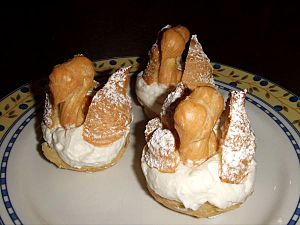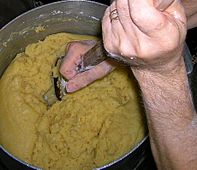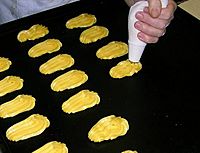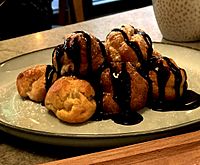Choux pastry facts for kids

Choux pastry swans
|
|
| Alternative names | Pâte à choux |
|---|---|
| Type | Pastry |
| Place of origin | France |
| Region or state | Paris |
| Created by | Panterelli |
| Main ingredients | Butter, flour, eggs, water |
Choux pastry, also known as pâte à choux in French, is a special kind of pastry dough. It's used to make many delicious desserts and snacks. The main ingredients are simple: butter, water, flour, and eggs. Sometimes other flavors are added too.
Unlike most doughs, choux pastry doesn't use a special powder to make it rise. Instead, it uses a lot of water. When it bakes, the water turns into steam. This steam puffs up the pastry, making it light and hollow inside. You can find choux pastry in many European foods, especially in French cuisine and Spanish cuisine. It's the base for popular treats like profiteroles, éclairs, and churros.
Contents
The Story of Choux Pastry
Some history books say that choux pastry was invented a long time ago in 1540. A chef named Pantanelli created it. He was the head chef for Catherine de' Medici, a famous queen. Pantanelli made a cake with this new dough and called it pâte à Pantanelli.
Over many years, the recipe changed. The name also changed to pâte à popelin. This dough was used to make small cakes called popelins. These cakes were named after Popelini, who took over as chef after Pantanelli. In the 1500s, rich people often ate popelins. They were flavored with things like cheese or lemon. The dough was first dried over a fire, which was called pâte à chaud (meaning 'hot pastry'). This is how the name pâte à choux came about. It's not because the pastry looks like a cabbage, even though "choux" means cabbage in French!
Later, in the 1700s, two royal chefs improved the recipe. Jean Avice and Antoine Carême worked for Marie Antoinette. They made changes that led to the choux pastry we know today, used for things like profiteroles.
How Choux Pastry Gets Its Puff
The main ingredients for choux pastry are butter, water, flour, and eggs. It's different from other pastries because it doesn't use a "raising agent" like baking powder. Instead, it uses the steam from its high water content to puff up.
To make it, you boil water and butter together. Then, you add the flour. This mixture cooks for a few minutes. This step makes the flour thick and allows it to hold a lot of water. After it cools a bit, you mix in enough eggs until the dough is just right. When this dough bakes, the water inside turns into steam, creating those wonderful hollow pockets.
Foods Made with Choux Pastry
Choux pastry is super versatile! It's used to make many different kinds of treats.
- Choux puffs: These are small, round puffs, just like the name suggests.
- Profiteroles: Small, round choux puffs often filled with cream and topped with chocolate sauce.
- Croquembouches: A tall cone of profiteroles stuck together with caramel.
- Éclairs: Long choux pastries filled with cream and topped with icing.
- Religieuses: A French pastry that looks like a nun, made from two choux puffs.
- French crullers: A twisted doughnut made from choux pastry, often fried.
- Beignets: These are fried choux pastry dough, often dusted with sugar.
- St. Honoré cake: A fancy French cake with a choux pastry base and cream puffs.
- Chouquettes: Small, hollow choux puffs covered in pearl sugar.
- Gougères: Savory choux pastry puffs, usually flavored with cheese.
While most choux pastries are baked, some are fried. For example, in Spain and Latin America, churros are made from fried choux pastry. They are often sugared and dipped in thick hot chocolate for breakfast. In Italy, zeppole di San Giuseppe are cream-filled choux pastries eaten on March 19th. In Austria, a type of apricot dumpling called Marillenknödel uses choux pastry. In this case, it stays dense and doesn't puff up.
Sometimes, choux pastries are filled with cream after they are baked. This is how you get delicious cream puffs or éclairs. A craquelin is a choux pastry with a "crackly" sugar topping. It's often filled with pastry cream, similar to an éclair.
Chouquette

Home-made chouquettes
|
|
| Type | Choux pastry |
|---|---|
| Place of origin | France |
| Main ingredients | choux pastry, nib sugar; custard or mousse |
A chouquette is a small, round, and hollow choux pastry. It's covered with pearl sugar. The name "chouquette" is a smaller version of "choux."
Unlike éclairs, which are also made from choux pastry, chouquettes are bite-sized. They are also hollow inside. Chouquettes come from Paris, France. You can enjoy them any time of day, whether for breakfast or as an afternoon snack!
Gallery
-
Mixing choux pastry dough for beignets
-
Piping out the dough for beignets with a pastry bag
See also
 In Spanish: Pasta choux para niños
In Spanish: Pasta choux para niños




